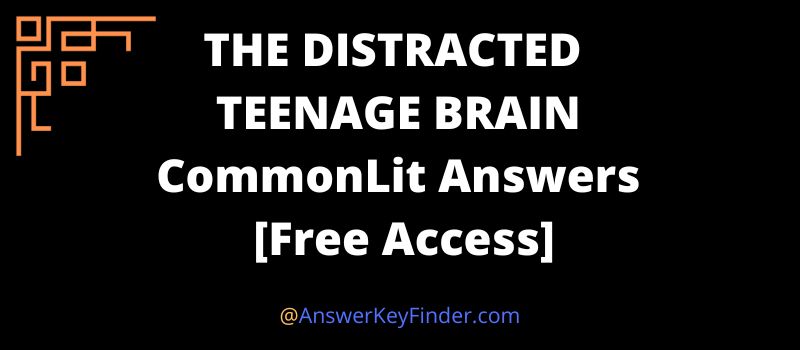In this session, we will be revealing THE DISTRACTED TEENAGE BRAIN CommonLit answers which are absolutely FREE to view.
Before publishing, every answer for THE DISTRACTED TEENAGE BRAIN CommonLit short story undergoes a thorough review to ensure its accuracy & reliability. If you find them helpful, please don’t hesitate to share.
THE DISTRACTED TEENAGE BRAIN CommonLit Answers – FREE Access
Find the answer key for the topic “THE DISTRACTED TEENAGE BRAIN” below:
Note: Be prepared to share your original ideas in a class discussion.

Discussion Questions & Answers
Following are our answers based on the questions provided:
Q.1. Are you surprised by the findings of this study? Why or why not?
Ans: Yes. I think this study is important to science because it explains why teens are engaging in risky behavior. I am not surprised by the findings of this study because it is important to science. The study provides an explanation for why teens engage in risky behavior, which is valuable information for understanding adolescent development and potentially developing interventions to promote healthier behaviors.
Q.2. In paragraph 11, one scientist makes the claim that the results of the study, which suggest that teens are more easily distracted by potential rewards, help prove why teens are more likely to engage in irresponsible behavior. In your opinion, is this a strong argument? What might be some other reasons teenagers make poor choices?
Ans: Yes because the study shows that teens are more easily distracted from finishing a goal by the idea of a possible reward than adults are, it can also explain why they are often distracted by ” rewards ” like reading a group chat immediately over the “goal” of looking both ways when crossing a street.
Q.3. In the context of this article, how can science define the identity of a teenager? Where does it fall short?
Ans: Science defines the identity of a teenager by looking at their physical, emotional, and cognitive development, as well as their social, educational, and economic backgrounds. However, science falls short in the following ways:
-It does not take into account the individual’s unique life experiences and beliefs.
-It does not account for the cultural and environmental contexts in which a teen may be living.
-It does not consider the pressures of peers and society that may shape a teen’s identity.
-It cannot measure the impact of family dynamics on a teen’s identity.
-It cannot assess how a teen’s identity may change over time.
Assessment Questions & Answers
Following are our answers based on the questions provided:
Q.1. PART A: Which of the following statements best expresses the central idea of the article?
Ans: Teenagers are more prone to distraction because they are more attracted to or focused on potential rewards.
Q.2. PART B: Which of the following quotes best supports the answer to Part A?
Ans: “‘The study demonstrates that the attention of adolescents is especially drawn to rewarding information'” (Paragraph 12)
Q.3. PART A: What does the word “entice” mean as used in paragraph 1?
Ans: to attract
Q.4. PART B: Which of the following phrases from paragraph 1 best supports the answer to Part A?
Ans: “allure of rewards”
Q.5. Analyze the claim the author makes about distracted teenage behaviors and evaluate whether the evidence used to support this claim is sufficient.
Ans: Once the teenage brain has linked a behavior to that reward, it continues to look for the reward again. After realizing a trial with green and red circles, where the participants had to find a correct target in order to get a reward, the rewards were announced by the team of Zachary Rooper. Teenage distractions and lack of attention could have something to do with their studying habits and their interests, not with the rewards they are expecting. This evidence is insufficient to support the statement that teenage brains are constantly seeking rewards. Therefore Roper’s claim can be applied partially to teenagers.
The author claims that the evidence provided is insufficient to support the statement that teenage brains are constantly seeking rewards. The evidence presented is a study where participants had to find a correct target in order to receive a reward. However, the author argues that teenage distractions and lack of attention may be attributed to their studying habits and interests rather than their desire for rewards.
You can find answer keys for other grades here:
=> CommonLit Answer [All Grades]
Note: In case, you have anything to share related to this topic let us know through the comment box below.
Conclusion
In CommonLit, “THE DISTRACTED TEENAGE BRAIN” is one of the students’ favorite studies conducted by Zachary Roper for grade 8 students.
In 2014 psychologist Zachary Roper conducted a study that offered a different definition of distraction. The results show why young adults may seem impulsive & easily distracted.
Hope you got THE DISTRACTED TEENAGE BRAIN CommonLit Answers Key for free as promised. Share with your batchmates if you find this helpful.
Hi, I’m Annie Smith, and I’ve been a teacher for over 5 years and have taught students at all levels. I love to help students get ahead of their exams and provide helpful guides on various topics.
